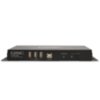Q-SYS Designer Software: Addresses Control, Platform, and Video Issues
Resolved Issue(s)
✔ ️Control - Improved performance on TSC Series touch screens when using multiple pages within a single User Control Interface (UCI).
✔ ️Control - HTML5 er sizes and border sizes now process and display properly when setting Viewport Relative Sizes for UCI styles.
✔ ️Platform - When the Dark Theme is toggled, colors now display properly (especially pinks and yellows) in Group Boxes and other Designer elements.
✔ ️Platform - Redundant Core configuration fail over time from Primary Core to Secondary Core is now improved.
✔ ️Video - Cameras no longer show as "None" in the USB Video Bridge control panel if multiple USB Video Bridges are included in the design with duplicate bridge names, allowing Zoom Compatibility mode to function as intended.
Known Issue(s)
- Audio - The AES67 Transmitter component Status shows "Not Present - (address not specified)" and you therefore cannot enable the stream.
- Audio - If you change the name of a Custom Voicing that is currently mapped to a 70/100V Speaker, the name does not update in the 70/100V Speaker component.
- Audio - If you enable the Low Pilot Tone in a Generic Speaker or Generic 70/100 V Speaker component connected to an idle 8-channel CXD-Q or DPA-Q amplifier, the impedance reading is below 1 ohm. As a result, the amplifier reports a short circuit fault.
- Control - Plugins configured to accept serial control connections do not receive serial commands if they are attached to a Command Buttons component.
- Control - For users running the Q-SYS Control app on iOS 14.0+, the app may no longer discover Cores on the network.
- Control - After switching a Core 510i or NV-32-H (Core Capable) to Core mode from Peripheral mode, if Access Control was previously enabled, you see this error if you attempt to upgrade the Core's firmware immediately after switching modes.
- Management - After saving and running a design to the Q-SYS Core processor, the Core Manager > Status page shows "Unavailable" in the Inventory section.
- Management - If you create an Organization and then return to the Organizations page, the new Organization is not visible in the list.
- Management - In a redundant Core configuration, after upgrading the Core firmware, the Enterprise Manager > Sites > Systems > Status page may show "Unavailable" in the Inventory section.
- Management - In a redundant Core configuration, a dynamically-paired NV-32-H might get stuck showing "Initializing" status in Enterprise Manager after redeploying a design file.
- Management - When attempting to add another Core to a Site, such as when adding the second of two Cores in a redundant pair System, the+ Add Core button is grayed out.
- Management - If you perform a Core reset, register the Core with Reflect, and then attempt to add that Core to a Site in Enterprise Manager, you see the aforementioned error.
- Management - If you attempt to open Peripheral Manager for an NV-32-H (Core Capable) recently switched to Peripheral mode, you may see only a blank page or a 404 error in the browser.
- Management - If you were logged in to Core Manager while upgrading Q-SYS, you may see the aforementioned errors. After refreshing the page, Chrome browsers may then report a "Connection is not private" warning.
- Management - If you attempt to access Core Manager from an iOS device, you may see the aforementioned error accompanied by a spinning blue circle.
- Management - If you specify SNMP settings on the Core Manager or Enterprise Manager > Network Services > SNMP page on a Core running Q-SYS 8.0.0 or 8.1.1 firmware, those settings are not retained after upgrading to version 9.2.x.
- Management - If you deploy a non-redundant design to a Core currently in standby as part of a redundant pair, Core Manager displays the aforementioned message despite the Core now running a non-redundant design.
- Platform -With a design running in Q-SYS Designer Software, this error appears. If you close the error, it appears again.
- Platform -On newer PCs with 11th Gen Intel Core Processors with Iris Xe GPUs, meters in Q-SYS Designer Software might freeze or not render correctly.
- Platform -When upgrading from Q-SYS version 9.1.2, if the Core loses LAN connectivity during the upgrade process and you attempt to upgrade again, the progress meter may freeze at 1% and the upgrade fails.
- Platform -After the Core reboots and attempts to load a design following a firmware update, you may see a "License expired" error. If you attempt to push the design again, the error reappears.
- Platform -When attempting to downgrade a Core to a version prior to v9.1.x, you see the aforementioned error message.
- Platform -If you attempt to group components (Tools > Group) that include Loudspeaker blocks, the Loudspeaker blocks disappear.
- Platform -If you enable Access Control in Q-SYS Core Manager and reboot the Core while Q-SYS Designer is actively connected to the running design, Designer's connection becomes unstable after the Core finishes rebooting.
- Video - If you attempt to run or emulate a design containing an I/O-USB Bridge peripheral and you have included all of its inventory components (USB Audio Bridge speakerphone or sound card, USB Video Bridge, USB In and Out, HID components), you receive the aforementioned compile error
- Video - If you wire the same AV stream to multiple inputs of a System Transmitter component (for example: AV Output 1 from an Encoder to AV s 1-6 of a System Transmitter) and then wire those same streams from a System Receiver component to a Decoder with dual outputs (HDMI Output Mode property is set to "HDMI 1 + HDMI 2"), you may see the aforementioned error when switching the Decoder's source if the is the same stream as before. In this scenario, HDMI output 2 will not display the stream.
- Video - If you change the HDMI I/O component Device Type property from Encoder to Decoder or vice versa and then redeploy the design, HDMI output may stop working.
- Video - In Q-SYS Configurator, if you change a Q-SYS PTZ camera's IP address from Static to Auto, the camera may be assigned a -local (169.254.x.x) address instead of a DHCP server-assigned address. This can occur if the camera has not previously been assigned an address by a DHCP server.
Note(s)
- Full 9.2.1 release note (with workarounds for current known issues).


